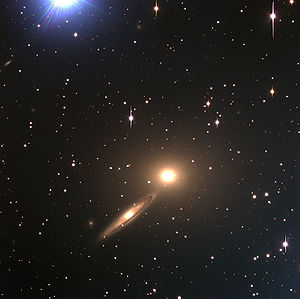NGC 5090
| Galaxie NGC 5090 | |
|---|---|
 | |
| Galaxienpaar NGC 5090 - 5091 | |
| AladinLite | |
| Sternbild | Zentaur |
| Position Äquinoktium: J2000.0, Epoche: J2000.0 | |
| Rektaszension | 13h 21m 12,8s[1] |
| Deklination | −43° 42′ 16″[1] |
| Erscheinungsbild | |
| Morphologischer Typ | E2 / LINER[1] |
| Helligkeit (visuell) | 11,5 mag[2] |
| Helligkeit (B-Band) | 12,5 mag[2] |
| Winkelausdehnung | 2,7′ × 2,2′[2] |
| Positionswinkel | 109°[2] |
| Flächenhelligkeit | 13,5 mag/arcmin²[2] |
| Physikalische Daten | |
| Zugehörigkeit | NGC 5011-Gruppe NGC 5090-Gruppe LGG 339[1][3] |
| Rotverschiebung | 0,011411 ± 0,000070[1] |
| Radialgeschwindigkeit | 3421 ± 21 km/s[1] |
| Hubbledistanz H0 = 73 km/(s • Mpc) | (145 ± 10) · 106 Lj (44,6 ± 3,1) Mpc [1] |
| Geschichte | |
| Entdeckung | John Herschel |
| Entdeckungsdatum | 3. Juni 1834 |
| Katalogbezeichnungen | |
| NGC 5090 • PGC 46618 • ESO 270-G002 • MCG -07-27-54 • 2MASX J13211286-4342168 • SGC 131818-4326.6 • GC 3496 • h 3487 • AM 1318-432 • LDCE 916 NED160 | |
NGC 5090 ist eine Elliptische Galaxie mit aktivem Galaxienkern vom Hubble-Typ E2[2] im Sternbild Zentaur am Südsternhimmel. Sie ist schätzungsweise 145 Millionen Lichtjahre von der Milchstraße entfernt und hat einen Durchmesser von etwa 125.000 Lichtjahren. Die Galaxie bildet zusammen mit NGC 5091 ein wechselwirkendes Galaxienpaar. In NGC 5090 wurde zudem ein Radio-Jet (FRI-Radiogalaxie) mit der Benennung PKS 1318-43 identifiziert. In der Nähe von NGC 5090 befinden sich zwei weitere Galaxien, die die Bezeichnung PGC 46442 (NGC 5090A) und PGC 46528 (NGC 5090B) erhielten.
Das Objekt wurde am 3. Juni 1834 von dem britischen Astronomen John Herschel entdeckt,[4] der bei der Beobachtung „pretty faint, round, 30 arcseconds. The third of four“[5] notierte. Die anderen Galaxien in dieser Gruppe sind NGC 5082, NGC 5086 und NGC 5091.
Weblinks
- Capella Observatory
- ESO (Memento vom 9. Januar 2009 im Internet Archive)
- Galaxis in Collision (Memento vom 11. Oktober 2011 im Internet Archive)
- GoBlack
- NGC 5090. SIMBAD, abgerufen am 27. Mai 2015 (englisch).
- A radio and optical study, bibcode:1986ApJ...308...36S
- NGC 5090. DSO Browser, abgerufen am 27. Mai 2015 (englisch).
Einzelnachweise
Auf dieser Seite verwendete Medien
Autor/Urheber: European Southern Observatory, Lizenz: CC BY 4.0
A pair of galaxies NGC 5090 - 5091 in Centaurus is shown in this image. They are located at about the same distance as ESO 269-57 and may belong to the same cluster of galaxies. This is an interacting elliptical-spiral system with some evidence of tidal disruption of NGC 5091 (to the left; seen under a steep angle) by NGC 5090 (to the right). The velocity of the nucleus of NGC 5091 has been measured as 3429 km/sec, while NGC 5090 has a velocity of 3185 km/sec. NGC 5090 is associated with a strong, double radio source (PKS 1318-43). This three-colour composite (BVR) was obtained with VLT UT1/ANTU and its FORS1 instrument in the morning of March 29, 1999. A bright star in the Milky Way, just outside the field at the upper left, has produced a pattern of blue straylight. The field size is 6.8x6.8 arcmin 2. North is up and East is to the left.
